Anti-Lamprey GnRH-I Antibody
This rabbit polyclonal antibody was generated against a synthetic peptide corresponding to wild-type Lamprey gonadotropin-releasing hormone (GnRH)-I and reacts with Lamprey GnRH-I
Highlights:
- Reacts with Lamrey GnRH-I
- Suitable for Immunocytomchemistry, Immunohistochemistry, and radioimmunoassay applications
Gonadotropin releasing hormone (GnRH), also known as luteinizing hormone releasing hormone (LHRH), is a key molecule in the regulation of reproduction in vertebrates. GnRH, a decapeptide, is produced by neurons in the medial basal hypothalamus (MBH) and secreted in a pulsatile manner into the cardiovascular system. The frequency and amplitude of GnRH pulses determine secretion of follicle stimulating hormone (FSH) and luteinizing hormone (LH) from the pituitary. Higher frequencies (greater than one pulse per hour) stimulate LH secretion while lower frequencies stimulate FSH secretion. The generation of GnRH pulses is effected by numerous stimuli, such as neural, hormonal and environmental. Therefore, behavioral and physiological conditions such as sleep, exercise, and stress can affect the GnRH pulses and cause a disruption of the normal cycle. Recent studies show that GnRH also has a role in mediating cancer. GnRH has been shown to inhibit the growth of human uterine leiomyloma cells by suppressing proliferation and inducing apoptosis. GnRH analogs have been used to treat a wide variety of reproductive cancers, although the side effects of using such compounds are often quite severe.
From the laboratory of Stacia A. Sower, PhD, University of New Hampshire.
This rabbit polyclonal antibody was generated against a synthetic peptide corresponding to wild-type Lamprey gonadotropin-releasing hormone (GnRH)-I and reacts with Lamprey GnRH-I
Highlights:
- Reacts with Lamrey GnRH-I
- Suitable for Immunocytomchemistry, Immunohistochemistry, and radioimmunoassay applications
Gonadotropin releasing hormone (GnRH), also known as luteinizing hormone releasing hormone (LHRH), is a key molecule in the regulation of reproduction in vertebrates. GnRH, a decapeptide, is produced by neurons in the medial basal hypothalamus (MBH) and secreted in a pulsatile manner into the cardiovascular system. The frequency and amplitude of GnRH pulses determine secretion of follicle stimulating hormone (FSH) and luteinizing hormone (LH) from the pituitary. Higher frequencies (greater than one pulse per hour) stimulate LH secretion while lower frequencies stimulate FSH secretion. The generation of GnRH pulses is effected by numerous stimuli, such as neural, hormonal and environmental. Therefore, behavioral and physiological conditions such as sleep, exercise, and stress can affect the GnRH pulses and cause a disruption of the normal cycle. Recent studies show that GnRH also has a role in mediating cancer. GnRH has been shown to inhibit the growth of human uterine leiomyloma cells by suppressing proliferation and inducing apoptosis. GnRH analogs have been used to treat a wide variety of reproductive cancers, although the side effects of using such compounds are often quite severe.
From the laboratory of Stacia A. Sower, PhD, University of New Hampshire.
| Product Type: | Antibody |
| Antigen: | Lamprey (l) GnRH-I GnRH |
| Accession ID: | P01148 |
| Clonality: | Polyclonal |
| Immunogen: | pGlu-His-Tyr-Ser-Leu-Glu-Trp-Lys-Pro-Gly |
| Species Immunized: | Rabbit |
| Buffer: | Antisera |
| Tested Applications: | ICC/IHC: Use at dilution of 1:4,000 (Tobet et al., 1995, Cell Tissue Research); RIA: Use at dilution at 1:100,000 (Stopa et al., 1998; Fahien and Sower, 1990; Calvin et al., 1993) |
| Comments: | 21-134: Polyclonal antibody was produced Calvin and Sower, UNH (Calvin et al., 1993). Two male white rabbits were injected with the aforementioned lamprey GnRH-I peptide, boosted and bled (Calvin et al., 1993). |
| Storage: | -80C |
| Shipped: | Cold Packs (Domestic, Overnight); Dry Ice (International) |
- Calvin, J.L., C.H. Slater, T.G. Bolduc, A.P. Laudano and S.A. Sower. 1993. Multiple molecular forms of gonadotropin-releasing hormone in the brains of an elasmobranch: evidence for ir-lamprey GnRH. Peptides. 14:725-729.
- Stopa, E.G., S.A. Sower, C.N. Svendsen, and J.C. King. 1988. Polygenic expression of gonadotropin-releasing hormone (GnRH) in human? Peptides. 9:419-423.
- Fahien, C.M. and S.A. Sower. 1990. Relationship between brain gonadotropin-releasing hormone and final reproductive period of the adult male sea lamprey, Petromyzon marinus. Gen. Comp. Endocrinol. 80:427-437.
- Tobet, S.A., M. Nozaki, J. H. Youson, and S.A. Sower. 1995. Distribution of lamprey gonadotropin-releasing hormone-III (GnRH-III) in brains of larval lampreys (Petromyzon marinus). Cell Tissue Research 279:261-270.
If you publish research with this product, please let us know so we can cite your paper.


